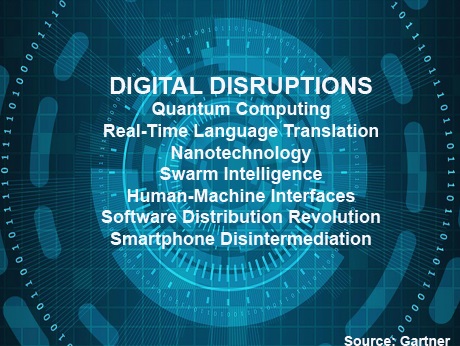
Mumbai, October 29, 2018: — Gartner has revealed seven digital disruptions that organizations may not be prepared for. These include several categories of disruption, each of which represents a significant potential for new disruptive companies and business models to emerge.
“The single largest challenge facing enterprises and technology providers today is digital disruption, says Darryl Plummer, vice president and Gartner Fellow. “The virtual nature of digital disruptions makes them much more difficult to deal with than past technology-triggered disruptions. CIOs must work with their business peers to pre-empt digital disruption by becoming experts at recognizing, prioritizing and responding to early indicators.”
The seven key digital disruptions CIOs may not seeing coming are:
Quantum Computing (QC) is a type of nonclassical computing that is based on the quantum state of subatomic particles. Classic computers operate using binary bits where the bit is either 0 or 1, true or false, positive or negative. However, in QC, the bit is referred to as a quantum bit or qubit. Unlike the strictly binary bits of classic computing, qubits can represent 1 or 0 or a superposition of both partly 0 and partly 1 at the same time.
Superposition is what gives quantum computers speed and parallelism, meaning that these computers could theoretically work on millions of computations at once. Further, qubits can be linked with other qubits in a process called entanglement. When combined with superposition, quantum computers could process a massive number of possible outcomes at the same time.
Real-Time Language Translation
Real-time language translation could, in effect, fundamentally change communication across the globe. Devices such as translation earbuds and voice and text translation services can perform translation in real-time, breaking down language barriers with friends, family, clients and colleagues. This technology could not only disrupt intercultural language barriers, but also language translators as this role may no longer be needed.
Nanotechnology
Nanotechnology is science, engineering and technology conducted at the nanoscale — 1 to 100 nanometers. The implications of this technology is that the creation of solutions involve individual atoms and molecules. Nanotech is used to create new effects in materials science, such as self-healing materials. Applications in medicine, electronics, security and manufacturing herald a world of small solutions that fill in the gaps in the macroverse in which we live.
Swarm Intelligence
Digital business will stretch conventional management methods past the breaking point. The enterprise will need to make decisions in real time about unpredictable events, based on information from many different sources (such as Internet of Things [IoT] devices) beyond the organization’s control. Humans move too slowly, stand-alone smart machines cost too much, and hyperscale architectures cannot deal with the variability. Swarm intelligence could tackle the mission at a low cost.
Swarm intelligence is the collective behavior of decentralized, self-organized systems, natural or artificial. A swarm consists of small computing elements (either physical entities or software agents) that follow simple rules for coordinating their activities. Such elements can be replicated quickly and inexpensively. Thus, a swarm can be scaled up and down easily as needs change. CIOs should start exploring the concept to scale management, especially in digital business scenarios.
Human-Machine Interfaces
Human-machine interface (HMI) offers solutions providers the opportunity to differentiate with innovative, multimodal experiences. In addition, people living with disabilities benefit from HMIs that are being adapted to their needs, including some already in use within organizations of all types. Technology will give some of these people “superabilities,” spurring people without disabilities to also employ the technology to keep up.
For example, electromyography (EMG) wearables allow current users who would be unable to do so otherwise to use smartphones and computers through the use of sensors that measure muscle activity. Muscular contraction generates electrical signals that can be measured from the skin surface. Sensors may be placed on a single part or multiple parts of the body, as appropriate to the individual. The gestures are in turn interpreted by a HMI linked to another device, such as a PC or smartphone. Wearable devices using myoelectric signals have already hit the consumer market and will continue migrating to devices intended for people with disabilities.
Software Distribution Revolution
Software procurement and acquisition is undergoing a fundamental shift. The way in which software is located, bought and updated is now in the province of the software distribution marketplace. With the continued growth of cloud platforms from Amazon Web Services (AWS), Microsoft, Google, IBM and others, as well as the ever-increasing introduction of cloud-oriented products and services, the role of marketplaces for selling and buying is gathering steam. The cloud platform providers realize (to varying degrees) that they must remove as much friction as possible in the buying and owning processes for both their own offerings and the offerings of their independent software vendors (ISVs) (i.e., partners). ISVs or cloud technology service providers (TSPs) recognize the need to reach large and increasingly diverse buying audiences.
Smartphone Disintermediation
The use of other devices, such as virtual personal assistants (VPAs), smartwatches and other wearables, may mean a shift in how people continue to use the smartphone.
CIOs and IT leaders should use wearability of a technology as a guiding principle and investigate and pilot wearable solutions to improve worker effectiveness, increase safety, enhance customer experiences and improve employee satisfaction.